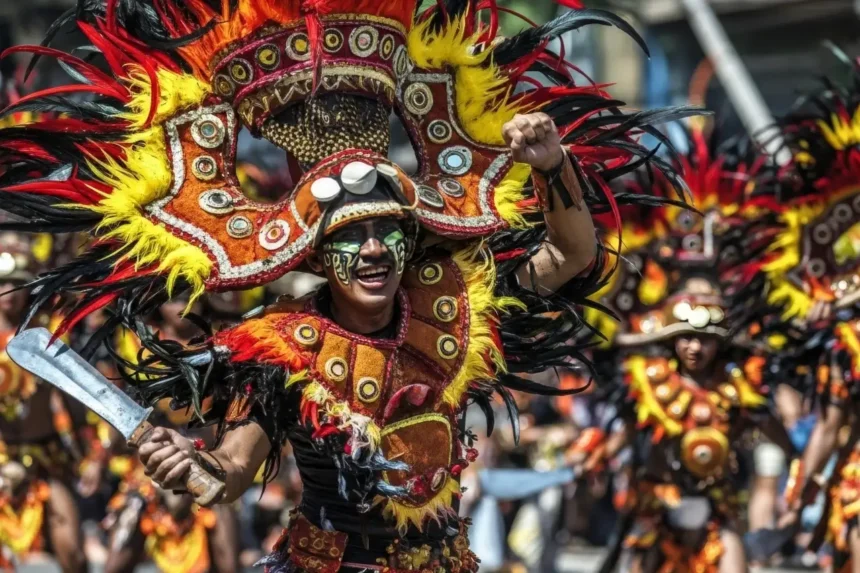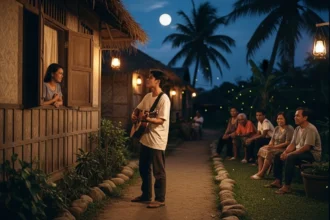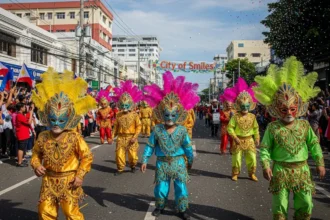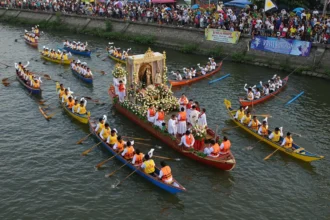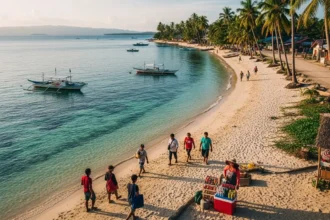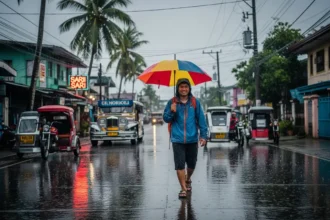Every January, the streets of Iloilo City explode with color, rhythm, and faith as the Dinagyang Festival takes over. Dancers painted in black soot, drums pounding like thunder, and shouts of “Viva Señor Santo Niño!” echo through the city – turning it into one of the liveliest fiestas in the Philippines.
More than just a show of energy, Dinagyang is Iloilo’s heartfelt tribute to the Sto. Niño (Child Jesus) – a symbol of faith and Filipino resilience. From the intense tribal dance competitions to the street parties that last all weekend, Dinagyang Festival 2026 promises a celebration that blends devotion, artistry, and pure joy.
If you’ve never danced along with the crowd or felt the beat of a thousand drums in your chest, this is your year to experience Iloilo’s pride – the festival that never sleeps. 🌞
📅 2026 Schedule & Key Events
The Dinagyang Festival 2026 will take place from January 23 to 25, 2026 (Friday to Sunday) in Iloilo City, with pre-festival activities starting as early as mid-January. It’s the city’s grandest tribute to the Sto. Niño, blending deep faith with world-class street performances that draw thousands of local and international visitors each year.
Dinagyang is divided into three main parts – religious, cultural, and competitive – all happening across Iloilo’s downtown streets and plazas. Expect sleepless nights, beating drums, and a sea of people moving as one.
Here’s a rundown of the Dinagyang 2026 major events:
| Date (2026) | Event / Activity | What to Expect |
|---|---|---|
| January 16–22 (Pre-Festival Week) | Opening Ceremonies & Novena Masses ⛪ | Church activities and novenas at San Jose Parish, home of the original Sto. Niño image. Evening food fairs and drumbeat exhibitions begin. |
| January 23 (Friday) | Pamukaw – Wake-Up Parade 🌅 | A lively dawn parade signaling the start of the festival. Locals in tribal costumes dance through streets to “wake” the city in honor of the Sto. Niño. |
| January 24 (Saturday) | Kasadyahan sa Kultura sa Iloilo 🎭 | A showcase of cultural and folk dances from across Western Visayas. Expect traditional music, colorful costumes, and community storytelling. |
| January 25 (Sunday) | Ati Tribes Competition & Grand Parade 🥁 | The heart of Dinagyang – high-energy performances by tribes representing different schools and barangays. Each group tells a story through dance, drums, and synchronized movements. |
| January 25 (Evening) | Religious Procession & Fireworks Display 🎆 | The image of the Sto. Niño is paraded through the city followed by fireworks lighting up the Iloilo River – a fitting close to the festival weekend. |
🌞 Local Experience – The Energy of Pamukaw
If you want to feel Dinagyang, wake up early for Pamukaw on Friday. Locals say it’s the soul of the festival – raw, joyful, and purely Iloilo. The dancers shout “Viva Señor Sto. Niño!” as the sun rises, and you’ll find yourself smiling before your first cup of coffee.
📍 Main Festival Zones
-
Downtown Iloilo (Freedom Grandstand) – Main stage for the Ati dance competition
-
Diversion Road & Iloilo Business Park – Street food lanes, concerts, and exhibits
-
San Jose Parish Church, Plaza Libertad – Religious center and Sto. Niño novena
Traveler’s Move – Go Early, Stay Late
Crowds grow fast by 8 AM during the grand parade. Secure a spot near Freedom Grandstand or book a hotel with balcony views early. After sunset, the energy doesn’t die – food stalls, live bands, and light shows keep the fiesta going until midnight.
🎭 Festival Highlights & Cultural Attractions
There’s no mistaking the sound of Dinagyang – a thunder of drums echoing through Iloilo’s streets, mixed with cheers and chants of “Viva Señor Sto. Niño!” It’s a celebration that feels alive in every sense – the kind that shakes the ground and fills your chest with pride.
🥁 The Ati Tribes Competition – Heartbeat of Dinagyang
The highlight of the festival is the Ati Tribes Competition, held every Sunday of Dinagyang weekend. This is where Iloilo’s best performers – often students and community groups – transform into tribes inspired by the Ati people, the original settlers of Panay Island.
Each group paints their bodies in black soot or brown pigment, symbolizing the Atis, and wears elaborate costumes made from feathers, beads, and native fabrics. The choreography is intense – synchronized jumps, drum rhythms, and storytelling all rolled into one.
Judges don’t just look for dance skills – they score storytelling, costume design, musicality, and faith expression. Every stomp and beat is a prayer in motion, honoring the Sto. Niño.
Local Hack – Catch the Best Angles
The best spots for photos are around Freedom Grandstand, Iloilo Capitol Grounds, and Iloilo Business Park. Arrive early (before 7 AM) – locals often camp out at dawn to secure a front-row spot.
⛪ The Sto. Niño Devotion
At its core, Dinagyang is still a religious festival. The original image of the Sto. Niño de Iloilo was brought by Spanish missionaries in 1967 – and it remains the spiritual centerpiece of the entire celebration.
Every morning, devotees line up at San Jose Parish Church to touch or pray before the image. Even performers – sweaty and exhausted after hours of dancing – pause to kneel before the altar.
Faith Note – Attend the Fluvial Procession
On Saturday morning, join the fluvial parade along the Iloilo River, where the Sto. Niño image sails across the water surrounded by flowers and candles. It’s one of the most peaceful yet moving moments of the entire weekend.
🎨 Costumes, Colors, and Chaos
If you love visual overload, Dinagyang is heaven. Every dancer’s costume is handmade, often taking months to prepare. Expect headdresses taller than your arm span, feathers that shimmer under the sun, and warriors leaping barefoot on hot asphalt – smiling through it all.
It’s not just art; it’s identity. The designs mix indigenous and modern styles, showing how Iloilo fuses tradition with innovation.
Cultural Gem – The Sound of Iloilo Drums
The festival’s signature drumbeat isn’t just random noise. Each tribe has its own rhythm – passed down, rehearsed, perfected. Locals say you can tell who’s performing just by listening to the beat echoing through the city.
🌃 Nightlife & Street Life After Dark
When the sun sets, Iloilo transforms into a street carnival. Stages pop up around Diversion Road and SM City area, with live bands, DJs, and dance-offs. Food stalls serve inasal, pancit molo, and cold beer until past midnight.
It’s still family-friendly, just more relaxed – a time when tourists, performers, and locals share one big post-parade celebration.
Traveler’s Move – Try the Dinagyang Food Fest
Held at Iloilo Business Park, this culinary strip showcases Ilonggo favorites like batchoy, kansi, barquillos, and biscocho. Bring cash – most vendors don’t take cards.
🧭 How to Get There & Travel Tips
Iloilo may be famous for its quiet charm the rest of the year – but come Dinagyang Festival, it transforms into a pulsing city of dance, devotion, and celebration. Getting there is simple, but to truly enjoy the festival, timing and planning are everything.
✈️ How to Get to Iloilo
| Route | Travel Time | Details & Tips |
|---|---|---|
| From Manila (Airplane) | 1 hour | Daily flights via Cebu Pacific, Philippine Airlines, and AirAsia to Iloilo International Airport. From the airport, take a shuttle van (₱50–₱70) or taxi (₱350–₱500) to the city proper. |
| From Cebu | 45 minutes | Direct flights available; ferry option via 2GO Travel (12 hours overnight). |
| From Bacolod (by Ferry) | 1 hour | Ride a FastCat or OceanJet from Bacolod Port to Iloilo City Pier. Best for those already touring Western Visayas. |
| From Manila (Ferry) | 20–22 hours | For adventure seekers: 2GO Travel sails weekly from Manila South Harbor to Iloilo. Bring snacks and patience – it’s long, but scenic. |
Traveler’s Timing Trick – Fly In Early Friday Morning
Flights get fully booked weeks before the festival. If you can, arrive Friday morning (January 23) to catch the Pamukaw parade and settle in before the crowds double by Saturday.
🏨 Where to Stay During Dinagyang
Hotels in Iloilo fill up fast, especially near the main performance zones. Book your stay two to three months ahead for good rates and proximity to the action.
| Area | Best For | Budget Range (per night) |
|---|---|---|
| Downtown Iloilo (Freedom Grandstand area) | Close to parades and main stages | ₱3,000–₱6,000 |
| Diversion Road / SM City Area | Food fests, nightlife, easy transport | ₱2,500–₱5,000 |
| Jaro District | Quieter, historical sites nearby | ₱1,800–₱3,500 |
| Mandurriao / Iloilo Business Park | Modern hotels, mall access, street concerts | ₱2,000–₱4,500 |
Local Hack – Pick a Balcony Room
Many hotels along General Luna Street and Diversion Road face the parade routes. Rooms with balconies double as private viewing spots – worth every peso if you want to skip the street crowds.
🚶 Getting Around the City
Iloilo is compact and commuter-friendly. You can hop on jeepneys for ₱15–₱20, ride taxis or Grab for convenience, or even join the locals walking from plaza to plaza.
Traveler’s Move – Walk, Don’t Rush
Traffic is heavy during parade hours, so walking is often faster – and you’ll discover small pop-up stalls, mural walls, and local drummers along the way.
🎒 What to Pack
✅ Light, breathable clothes (January is sunny but breezy)
✅ Cap, shades, and sunscreen
✅ Comfortable shoes or sandals (you’ll walk a lot!)
✅ Small towel or fan
✅ Power bank and refillable water bottle
✅ Cash – many stalls are cash-only
✅ Earplugs (those drums get loud!)
Festival Hack – Go Hands-Free
Bring a small crossbody bag or fanny pack – you’ll need your hands free for clapping, cheering, or maybe even joining the crowd dance.
🍽️ What to Eat in Iloilo
Don’t just come for the dances – come hungry. Iloilo is home to some of the best comfort food in the country.
Must-tries include:
-
La Paz Batchoy – rich noodle soup from Netong’s or Ted’s.
-
Pancit Molo – Iloilo’s signature dumpling soup.
-
Kansi – a tangy beef stew, perfect for hangovers after street parties.
-
Biscocho and Barquillos – sweet crunchy pasalubong treats.
-
Inasal and seafood – especially at Tatoy’s Manokan or Breakthrough Restaurant near the coast.
Foodie Secret – Try the “Batchoy Battle”
Locals love to debate who serves the best batchoy. So do your own taste test – Ted’s, Deco’s, Netong’s, or the lesser-known Inggo’s. Each has loyal fans and slightly different recipes.
🔥 Dinagyang History & Cultural Significance
Before the lights, feathers, and booming drums, Dinagyang began as a quiet act of faith. The story starts in 1967, when a replica of the Sto. Niño de Cebu was brought to San Jose Parish Church in Iloilo City. What began as a simple thanksgiving procession soon grew into a vibrant, rhythmic expression of devotion – uniquely Ilonggo in spirit.
By 1968, the local parish organized the first formal Dinagyang celebration, inspired by Cebu’s Sinulog and Aklan’s Ati-Atihan. But Iloilo gave it its own heartbeat – tribal choreography, thunderous drums, and synchronized dance storytelling that would eventually define the festival’s identity.
🎭 The Meaning Behind “Dinagyang”
The word “Dinagyang” comes from the Hiligaynon word “dagyang,” which means to make merry or to revel in happiness. It perfectly captures the festival’s mood – joyful chaos powered by devotion and pride.
At its core, Dinagyang is a dual celebration:
-
Religious: Honoring the Sto. Niño as a symbol of faith and protection.
-
Cultural: Paying tribute to the Ati people, the island’s earliest inhabitants.
Every drumbeat represents gratitude; every leap is a prayer. The dancers – faces painted black to honor the Atis – don’t just perform for trophies; they perform for blessings.
Faith Insight – Dance as Devotion
Many participants say they join Dinagyang as an alay or panata. Some dance to give thanks for answered prayers, others for healing or protection. That’s what gives each performance its soul – it’s not just talent, it’s testimony.
🪶 The Ati Connection
Long before Spanish ships arrived, the Ati tribes lived peacefully across Panay Island. The festival honors their presence through tribal dance – not as imitation, but as respect and remembrance of the island’s first settlers.
Each tribe’s performance tells a story – about nature, ancestry, or faith – blending indigenous rhythm with modern choreography. The dancers’ dark body paint symbolizes the Ati’s brown skin and resilience, while the Sto. Niño image represents how faith united different cultures through time.
Cultural Gem – Unity in Diversity
In Dinagyang, ancient and modern meet. The warriors dance beside floats of angels; ancestral drums echo through city skyscrapers. It’s Iloilo’s way of saying: we can move forward without forgetting who we are.
🌏 From Local Devotion to Global Stage
By the 1990s, Dinagyang evolved into a world-class festival, earning national recognition from the Department of Tourism as one of the “Best Tourism Events in the Philippines.”
It has since represented the country in cultural expos across Asia, Europe, and the U.S., proudly carrying Iloilo’s artistry to the global stage. Yet even with international fame, its roots remain unshaken – a child’s prayer to the Sto. Niño, echoed by the entire city.
Cultural Legacy – More Than a Festival
Dinagyang isn’t just Iloilo’s pride – it’s a symbol of Filipino joy and faith surviving through centuries. It shows how we celebrate even through hardship, how faith becomes song and movement, and how culture continues to dance long after the drums stop.
💡 Travel Hacks & Local Tips for First-Timers
The Dinagyang Festival can be overwhelming – loud drums, painted dancers, packed streets, and nonstop energy. But that’s exactly what makes it special. With the right timing and a few local tricks, you can experience it like a true Ilonggo, not just a tourist.
🕕 Arrive Early and Plan Around the Crowds
Hotels, restaurants, and transport get booked solid weeks ahead, so plan early. The festival’s peak is Saturday and Sunday, when the tribal competition and grand parade happen.
If you want a more relaxed experience, come to Iloilo by Thursday (January 22) or Friday morning (January 23). You’ll catch the build-up – street rehearsals, band parades, and food fairs – before the main chaos begins.
Timing Trick – Early Bird View
Wake up before sunrise on Sunday (January 25) and head to Freedom Grandstand. Grab a seat before 7 AM – it fills up fast, but you’ll get the best view of the competing tribes as they enter the main stage.
🥁 Find the Best Viewing Spots
Dinagyang happens all over Iloilo, but some areas offer the perfect vantage points for both photos and atmosphere.
| Spot | Why It’s Great |
|---|---|
| Freedom Grandstand | Main performance area; best for official judging scenes. |
| Iloilo Business Park (Megaworld) | Street concerts, night parties, and food stalls. |
| Plaza Libertad | Historical setting; great for morning processions. |
| General Luna Street | Crowded but alive with tribal dancing and street vendors. |
Traveler’s Move – Follow the Sound
If you’re lost, don’t panic – just follow the rhythm of the drums. Every beat leads you to another tribe, another street, another story in motion.
💰 Budget Tips for Dinagyang Travelers
You can enjoy Dinagyang on almost any budget. Here’s a practical breakdown for a 3D2N stay in Iloilo:
| Expense | Estimated Cost (₱) |
|---|---|
| Roundtrip flight (Manila–Iloilo) | ₱3,000–₱5,000 |
| Accommodation (2 nights) | ₱2,500–₱4,500 |
| Food & drinks | ₱1,000–₱1,500 |
| Souvenirs & pasalubong | ₱500–₱800 |
| Local transport | ₱300–₱500 |
| Total Estimate | ₱7,300–₱12,000 |
Budget Move – Eat Like a Local
Skip the hotels and dine at carinderias near Jaro Plaza or La Paz Market. Try batchoy, molo soup, or grilled seafood – ₱120 is enough for a filling Ilonggo meal.
🎒 What to Pack
✅ Light, breathable clothes (January is sunny and warm)
✅ Comfortable shoes – you’ll walk a lot
✅ Small towel or fan
✅ Sunscreen and sunglasses
✅ Power bank (photo ops everywhere!)
✅ Cash (ATMs run out fast during the weekend)
✅ Reusable water bottle
Festival Hack – Dress Bright, Travel Light
Wear colorful clothes – it makes photos pop and helps you blend into the crowd. Bring only what you need, as pickpockets occasionally roam crowded areas.
🍽️ Eat, Explore, and Enjoy Iloilo
Dinagyang might be the main draw, but Iloilo’s charm doesn’t end when the drums stop. Extend your stay to discover the city’s gentle side:
-
La Paz Public Market – the birthplace of authentic batchoy
-
Jaro Cathedral – historic church and pilgrimage site
-
Esplanade Riverwalk – perfect for a sunset stroll
-
Molo Mansion – restored heritage house turned cultural café
-
Gigantes Islands (via Carles) – side trip for white sand beaches and island hopping
Local Secret – Talk to the Vendors
Street vendors know the city better than any map. Ask them for food recos or shortcut routes – you’ll get real stories, and maybe even a discount on your biscocho pasalubong.
❤️ More Than a Festival
By the time the drums fade and confetti settles, you’ll realize Dinagyang isn’t just a spectacle – it’s an emotional high. It’s faith in motion, joy in rhythm, and community in color.
As the Ilonggos say, “Ang Dinagyang, indi lang ginasaulog – ginabatyag.”
(Dinagyang isn’t just celebrated – it’s felt.)
❓ FAQs About Dinagyang Festival 2026
1. When is the Dinagyang Festival 2026 celebrated?
The Dinagyang Festival 2026 happens from January 23 to 25, 2026, in Iloilo City. Pre-festival novenas, food fairs, and concerts start as early as January 16, so arriving a few days early lets you catch the buildup and avoid the main-day crowds.
2. What is the Dinagyang Festival about?
Dinagyang is both a religious and cultural celebration honoring the Sto. Niño (Child Jesus) and the Ati people, the island’s earliest settlers. It’s Iloilo’s expression of faith, creativity, and community – a fusion of prayer and performance.
3. What does “Dinagyang” mean?
The word “Dinagyang” comes from the Hiligaynon term “dagyang,” which means to make merry or rejoice. It perfectly describes the festival’s spirit – joyful noise, dancing in the streets, and a celebration of blessings shared.
4. What are the highlights of the Dinagyang Festival 2026?
Expect the Ati Tribes Competition, Kasadyahan cultural dance showcase, Pamukaw parade, and the religious fluvial procession of the Sto. Niño. Each event shows a different side of Iloilo – devotion by day, and pure fiesta energy by night.
5. Where are the main events held?
Most major performances happen at the Freedom Grandstand, Downtown Iloilo, and Iloilo Business Park. The parades pass through General Luna Street, Plaza Libertad, and Diversion Road, where food stalls and drumlines fill every corner.
6. Is there an entrance fee to the festival?
No – Dinagyang is free and open to everyone, though seating at the main grandstand may require tickets. For a more authentic vibe, stand along the streets with locals and feel the drums up close.
7. How can I get to Iloilo for the festival?
Fly directly from Manila or Cebu to Iloilo International Airport, just an hour away. From there, hop on a van or taxi to downtown Iloilo, where most of the parades and street parties take place.
8. What should I wear to the Dinagyang Festival?
Wear light, breathable clothes and comfortable footwear – you’ll be walking and dancing under the sun. Don’t forget your hat, sunscreen, and refillable water bottle to stay cool throughout the day.
9. What food should I try while in Iloilo?
Iloilo is a foodie paradise – try La Paz Batchoy, Pancit Molo, Kansi, and Inasal for hearty local flavors. For pasalubong, grab Biscocho, Barquillos, or Butterscotch bars, all proudly made by Ilonggos.
10. What makes Dinagyang Festival unique?
Dinagyang stands out for its world-class tribal choreography and deep faith connection. It’s a festival where every beat, dance, and smile is both a performance and a prayer – truly Iloilo’s living expression of devotion.
🌞 Feel the Faith and Fire of Iloilo
The Dinagyang Festival 2026 isn’t just a spectacle – it’s a pulse. A heartbeat you can feel through the ground, the drums, and the smiling faces that fill Iloilo’s streets every January. It’s faith dressed in feathers, devotion danced in rhythm, and joy shared with strangers who feel like family by the end of the day.
If you’ve ever wanted to see what Filipino faith looks like when it moves, dances, and celebrates – this is it. Book your flights early, come hungry, wear your brightest smile, and let yourself get swept away in the energy of “Viva Señor Sto. Niño!”
Because in Iloilo, faith doesn’t just live in churches – it dances in the streets. 💃✨
🧭 References
-
Wikipedia – Dinagyang Festival
-
Carnifest – Dinagyang Festival in Iloilo City, Philippines 2026 | Dates & Venues
-
Philippine News Agency – Iloilo City hikes festival budget to P50-M in 2025
-
Daily Guardian – Iloilo Sports Complex Eyed for Dinagyang 2026
-
VacationHive – Dinagyang Festival | Things To Do in Iloilo City



